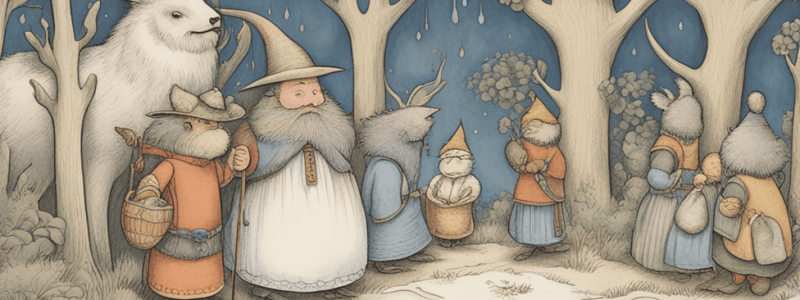Podcast
Questions and Answers
What was the main reason for Russian colonization of Central Asia?
What was the main reason for Russian colonization of Central Asia?
- To establish political and economic influence (correct)
- To promote cultural exchange
- To spread religious teachings
- To support local tribes in the region
In 603, the Turkic Kaganate split into which two divisions?
In 603, the Turkic Kaganate split into which two divisions?
- Mountainous and Plains Turkic Kaganate
- Western and Eastern Turkic Kaganate (correct)
- Coastal and Inland Turkic Kaganate
- Northern and Southern Turkic Kaganate
Who was known as Sagynbay Orozbakov?
Who was known as Sagynbay Orozbakov?
- A poet (correct)
- A scientist
- A warrior leader
- A religious figure
- A merchant
What did the Neolithic Revolution signify?
What did the Neolithic Revolution signify?
Who was the founder of the Turgesh Kaganate?
Who was the founder of the Turgesh Kaganate?
The first president of the Kyrgyz Republic was?
The first president of the Kyrgyz Republic was?
The Civil War in Kyrgyzstan was primarily between which forces?
The Civil War in Kyrgyzstan was primarily between which forces?
Which writing system was prevalent during the period of the Koqand Khanate?
Which writing system was prevalent during the period of the Koqand Khanate?
What did the term 'Homohabilis' signify in ancient Kyrgyz culture?
What did the term 'Homohabilis' signify in ancient Kyrgyz culture?
Who was the commander of the 316th Rifle Division during the Great Patriotic War?
Who was the commander of the 316th Rifle Division during the Great Patriotic War?
Flashcards are hidden until you start studying
Study Notes
The Great Mongol Empire
- Founded by Genghis Khan (Temujin) who was announced as its leader in 1206.
- Genghis Khan, meaning "Universal Khan," led Mongolian tribes through a crucial meeting known as kurultai.
- Four sons from his main wife Borte: Kuchi, Chaghatay, Ugedey, and Toluy.
Kyrgyz History and Leadership
- The Chaghatay Uulus, important for Mongol history, is connected with the Kyrgyz' development.
- 16th-century leader of the Kyrgyz was Barsbek, representing the tribal structures divided into two towns: On (right) and Sol (left).
- Ethnogenesis reflects the formation and development of ethnic groups.
Recruitment and Diplomacy
- First embassy sent to Russia in 1785.
- Mikhail Gorbachev's policy known as Perestroika aimed at economic reform and restructuring the Soviet Union.
Notable Figures and Events
- Chandan Kumar led the February Revolution in Kyrgyzstan.
- Nikolai Ludovich Vanov addressed the meaning of democracy.
- Yusef Balasagun wrote the Turkish poem "Kutadgu Bilig," translating to "Blessed Knowledge."
Land and Water Reforms
- Water reform efforts in southern Kyrgyzstan occurred in the early 20th century (1920-21) aiming to address irrigation issues.
- Muhammad Kyrgyz sought to unify Kyrgyz tribes and counter Mongol dominance.
Establishment of Autonomy
- Kyrgyz Autonomous Republic established in 1926.
- Kurmanzhan Datka ruled a faction in southern Kyrgyzstan during anti-Soviet struggles.
Conflicts and Issues
- Main conflict issue between Kyrgyz and Uzbeks centered on land disputes leading up to 1990 (Oshev incident).
- Essence of land and water reforms in the 20th century focused on redistributing resources among Kyrgyz and Russian entities.
Cultural Contributions
- Sultanbirzhanov and Baimagambetov played critical roles in closing the emble of an enemy bunker during World War II.
- Mahmud al-Kashgari authored the Arabic-Turkish dictionary "Divan Lugat al-Turk."
Historical Capitals and Religion
- Balasagun was the capital of the Qarakhani Khanate (900-1200).
- Islam was declared the official religion of the Qarakhani Khanate by Musa.
- The Kyrgyz established the Kyrgyz Khanate in the 7th century along the middle Yenisei River.
Transition to Soviet Republic
- Kyrgyz Autonomous Republic transformed into the Kyrgyz Soviet Socialist Republic in 1936.
- Main religion of the Qarakhani Khanate centered on Islam, shaping cultural and political identity.
Studying That Suits You
Use AI to generate personalized quizzes and flashcards to suit your learning preferences.




